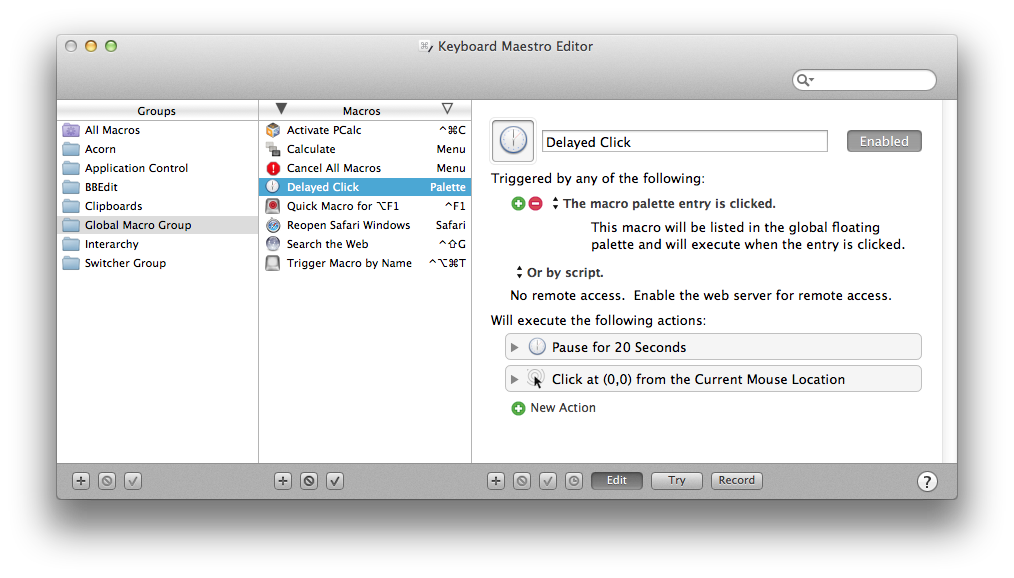![]() Keyboard Maestro 6
Keyboard Maestro 6
Conduct your Mac Like a Pro!
![]() Keyboard Maestro 6
Keyboard Maestro 6
Conduct your Mac Like a Pro!
Macros, also known as Shortcuts, are a way of improving your productivity by allowing you to perform repetitive or frequently required actions more quickly and accurately, tailoring your Mac to your usage patterns.
A macro consists of a set of zero or more possible Macro Triggers which define when the macro will be executed, together with an ordered list of Macro Actions to be performed. Sets of Macros are collected together into Macro Groups.
A typical simple Macro consists of a single Hot Key trigger, such as Control-A, together with a single action, such as “type my address” .
To create a Macro, first launch Keyboard Maestro, select the desired Macro Group to contain it, and then click the button below the Macros list. To edit a Macro, double click it, or select it and press the button. The Macro Editor window will be displayed.

Enter the name of your new Macro (you can skip this and it will be named for you based on the action you select).
You can create a new trigger by clicking on the green button. There are several Macro Triggers to choose from, the most common being the Hot Key which allows you to execute the Macro at the press of a key. You can define several different triggers, and any of the triggers will execute the Macro Actions. You can delete a trigger by clicking the red button.
You can add a new action by clicking the button or the button at the bottom of the macro detail view to display the list of actions. There are many Macro Actions to choose from. The actions you include will be executed in order. You can reorder the actions by dragging them around. You can copy actions by Option-Dragging or by using Copy and Paste. You can delete an action by selecting it and pressing the Delete key. You can enable or disable actions by selecting them and clicking the button at the bottom of the macro detail view. You can set the timeout of an action by clicking the button at the bottom of the macro detail view
An easy way to generate macro actions is to turn on recording by clicking the button at the bottom of the macro detail view and proceeding to show Keyboard Maestro what you want to do. Then turn recording back off and look through the actions. Chances are you will need to delete or adjust some of the recorded actions to make a robust macro, but this will be much quicker than creating each macro action manually.
You can display more or less detail about some actions by clicking the disclosure triangle. While disclosed, you can try the action immediately by clicking the button at the top right of the action. You can disclose all the actions (in a sublist) simultaneously by option clicking on the disclosure triangle.
You can try the actions immediately by selecting some or all of them and clicking the button at the bottom of the macro detail view.
Macros are continuously saved, so the macro is live as soon as it is created. It will be available immediately (subject to the restrictions of the Macro Group it is contained in).
You execute a macro’s action sequence by triggering the macro using any of the Macro Triggers you have defined.
You can also trigger macros by name using the Trigger Macros by Name action, which in turn can be in a macro and triggered any way you desire.
If the web server is enabled for remote access, you can trigger a macro remotely after logging in using a web browser or the Keyboard Maestro Control iPhone application.
You can also trigger a macro using AppleScript or another scripting language (select the “Or by script” entry to display script code in various languages such as AppleScript or Perl).
Note that the web server needs to be separately enabled in the Web Server preference pane, and all macros are subject to the restrictions of the Macro Group they are contained in. If the Macro Group is not enabled and active, the macro will not be available.
You can disable or enable a macro by selecting it and clicking the button at the bottom of the Macros list. You can also disable or enable a Macro using the Set Macro Enable action, or from AppleScript with:
tell application "Keyboard Maestro" setMacroEnable "Macro Name or UID" with/without enable end tell
You can start editing a Macro or Macro Group from AppleScript with:
tell application "Keyboard Maestro" editMacro "Macro Group Name or UID" end tell
See also the Macro Groups, Macro Actions, Macro Triggers and Recording sections.